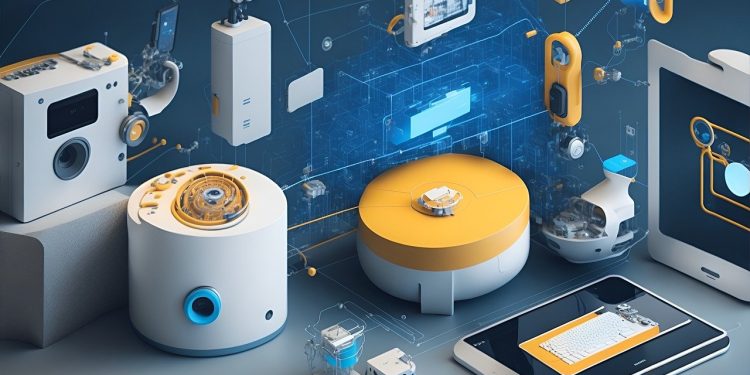The concept of a “smart home” has transitioned from futuristic fiction to an everyday reality, thanks to the Internet of Things (IoT). From voice-controlled assistants that can manage our schedules to thermostats that automatically adjust to our comfort levels, IoT is rapidly changing the way we live. In a connected home, everyday devices like refrigerators, lights, and security cameras communicate with each other, bringing convenience, efficiency, and security to our fingertips. This article delves into the fascinating ways in which IoT is transforming homes and explores how these changes are enhancing our daily lives.
The Foundation of Smart Homes: Understanding IoT
The Internet of Things refers to the concept of connecting everyday devices to the internet, allowing them to send and receive data. This network of interconnected devices enables them to work together seamlessly. Imagine your alarm clock ringing in the morning and automatically notifying your coffee maker to start brewing—that’s IoT in action. The smart home concept centers around using IoT to make daily routines simpler, more efficient, and ultimately more enjoyable.
Smart homes rely on sensors, wireless technology, and intelligent software that communicate with each other and with users via smartphones or central hubs. These hubs act as the brain of the smart home, integrating with different devices to provide centralized control over a range of functions, from lighting and entertainment to climate and security.
Smart Assistants: The Heart of Home Automation
Voice-activated smart assistants like Amazon Alexa, Google Assistant, and Apple Siri have become central figures in IoT-powered homes. These AI assistants respond to voice commands, answer questions, control smart home devices, and even automate household routines. With just a voice command, you can adjust the lights, set reminders, or play your favorite music.
Alexa, for example, integrates with hundreds of compatible devices, allowing users to control everything from thermostats to door locks. Google Assistant excels in contextual understanding and searches, making it a great companion for answering queries or managing events on your calendar. Siri, on the other hand, integrates seamlessly with Apple devices, ensuring that your iPhone, Apple Watch, and HomePod are all in sync.
These smart assistants provide an added level of convenience, but they also serve as an entry point to the broader IoT ecosystem, acting as controllers that unify all connected devices. The ability to group multiple actions into routines or scenes means you can, for instance, create a “Goodnight” routine that turns off the lights, locks the doors, and adjusts the thermostat—all with a simple command.
Intelligent Lighting: Setting the Mood and Saving Energy
Lighting is one of the most popular elements of a smart home, with IoT transforming how we illuminate our living spaces. Smart bulbs like Philips Hue and LIFX can be controlled via apps or voice commands, allowing users to change colors, dim lights, or create schedules to suit different times of day.
Intelligent lighting goes beyond convenience—it also offers significant energy savings. By using occupancy sensors, smart lighting systems can automatically turn lights on or off based on whether someone is in the room, reducing unnecessary energy use. These lights can also be programmed to gradually brighten in the morning to mimic natural sunlight, making waking up a more pleasant experience.
Another key benefit of smart lighting is the ability to create personalized scenes. Whether you’re hosting a dinner party or settling in for a movie night, lighting can be adjusted to create the perfect ambiance with minimal effort. These features not only enhance comfort but also promote energy-efficient habits by preventing lights from being left on unnecessarily.
Smart Thermostats: Climate Control with a Brain
Smart thermostats like Nest and Ecobee are making homes more comfortable while reducing energy bills. These devices learn your routines and adjust the temperature accordingly, ensuring that your home is always at an ideal temperature without wasting energy. For instance, if the thermostat knows that you leave for work at 8 AM, it will automatically adjust the temperature to conserve energy while you’re away.
Many smart thermostats also come with remote control features, allowing you to adjust the temperature via your smartphone while you’re on your way home. Advanced models even use geofencing to detect when you’re approaching, adjusting the climate to your preferred setting before you walk through the door. This level of automation is not only convenient but also helps minimize energy consumption, promoting a more sustainable lifestyle.
Additionally, smart thermostats provide detailed energy usage reports, allowing homeowners to see where they might be able to cut back on consumption. By identifying patterns in heating and cooling, users can make more informed decisions about how they manage energy in their homes, ultimately reducing their environmental footprint.
Connected Security Systems: Keeping Your Home Safe
Home security has always been a priority for homeowners, and IoT has taken it to a whole new level with connected security systems. Smart cameras, doorbell cameras, motion sensors, and smart locks all work together to provide a comprehensive security network for your home. Companies like Ring, Arlo, and Wyze offer smart cameras that can stream real-time footage directly to your phone, providing peace of mind whether you’re at home or on vacation.
Smart doorbells equipped with cameras and two-way audio let you see and communicate with whoever is at your door, even if you’re not home. Motion detectors can send instant alerts if unexpected activity is detected around your property, while smart locks from brands like August and Yale allow you to remotely control access to your home—perfect for letting in a family member who forgot their keys or granting temporary access to a guest.
Many of these security systems are integrated with voice assistants, allowing users to check their security status or lock their doors with a simple voice command. Beyond convenience, these connected systems provide an additional layer of safety, ensuring that your home is always secure and that you are immediately alerted to any potential issues.
Smart Appliances: The Connected Kitchen and Beyond
IoT has also found its way into the kitchen and other household appliances, transforming everyday tasks into seamless experiences. Smart refrigerators can keep track of the groceries inside, suggest recipes based on available ingredients, and even allow you to see inside via a connected app. Samsung’s Family Hub refrigerator, for instance, serves as a central communication tool for the household, complete with calendars, notes, and even entertainment options.
Smart ovens can be preheated remotely, while dishwashers and washing machines can be programmed to run at the most energy-efficient times of the day. This integration not only saves time but also helps manage household resources more efficiently. For those who enjoy cooking, devices like the Instant Pot Smart WiFi allow you to control and monitor your cooking progress from your phone, adding a layer of convenience to meal preparation.
Smart vacuums, like the popular Roomba, take care of cleaning without human intervention. These devices can be scheduled to clean at specific times, and many now come with mapping technology that helps them efficiently navigate around furniture and obstacles. For those looking to simplify household chores, these smart appliances offer a way to offload mundane tasks, freeing up more time for other activities.
Energy Management: Smarter Power Usage
IoT is also changing how we think about energy consumption in the home. Smart plugs and energy monitoring systems give homeowners insight into their power usage and help identify appliances that are consuming excessive electricity. Smart plugs can be scheduled or controlled remotely, allowing users to switch off devices that aren’t in use, which is particularly useful for energy “vampires”—appliances that draw power even when turned off.
Solar power systems are increasingly being integrated into smart home ecosystems. IoT-enabled solar panels can provide real-time data on energy production and consumption, allowing homeowners to make the most out of renewable energy sources. When paired with battery storage systems, IoT technology can even optimize the use of stored power, ensuring that homes remain energy-efficient and less reliant on the grid during peak hours.
Entertainment: Seamless, Personalized Experiences
The Internet of Things is also transforming home entertainment by offering more personalized, connected experiences. Smart speakers, like Amazon Echo and Google Nest Audio, do more than play music; they act as a hub for controlling other smart devices, answer questions, and offer voice-activated entertainment options.
Streaming devices like Chromecast, Apple TV, and Amazon Fire Stick have redefined how we watch television, making it easy to stream content from your phone, tablet, or laptop directly to your TV. These devices can be integrated with other smart home systems, enabling voice control for an even more seamless entertainment experience. Imagine asking Alexa to dim the lights, lower the blinds, and start your favorite movie—all without lifting a finger.
Multi-room audio is another trend enabled by IoT, allowing you to play music throughout your entire home or just in specific rooms, all controlled through an app or smart assistant. This synchronized experience brings a new level of convenience and enjoyment to home entertainment, making it easy to set the mood for any occasion.
The Challenges of IoT in the Home
Despite its many benefits, IoT in the home does come with some challenges. Privacy and data security are major concerns, as each connected device presents a potential point of vulnerability. Ensuring that your smart home devices are secured with strong passwords and kept up to date with the latest software is crucial for mitigating these risks.
Compatibility between different brands and devices can also be an issue. Not all devices play nicely with each other, which can lead to frustration when attempting to create a cohesive smart home experience. To address this, industry standards such as Matter are being developed to improve compatibility across devices from different manufacturers, making it easier for homeowners to choose and integrate different smart gadgets.
Living Smarter with IoT
The Internet of Things is transforming homes in incredible ways, adding convenience, comfort, and efficiency to everyday life. Whether it’s a thermostat that knows when to adjust the temperature, lights that respond to your voice, or a vacuum that cleans while you’re at work, IoT is enhancing how we interact with our living spaces. As technology continues to evolve, the potential for smart homes will only grow, offering even more exciting and intuitive ways to improve our quality of life.
If you’re thinking about turning your house into a smart home, start by identifying the areas where automation could benefit you most, such as energy management, security, or entertainment. With an ever-growing range of connected devices and solutions, there has never been a better time to explore the possibilities of IoT and make your home smarter, safer, and more efficient.






